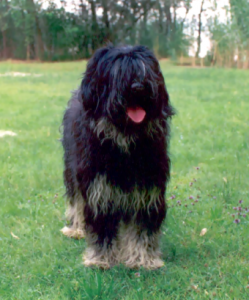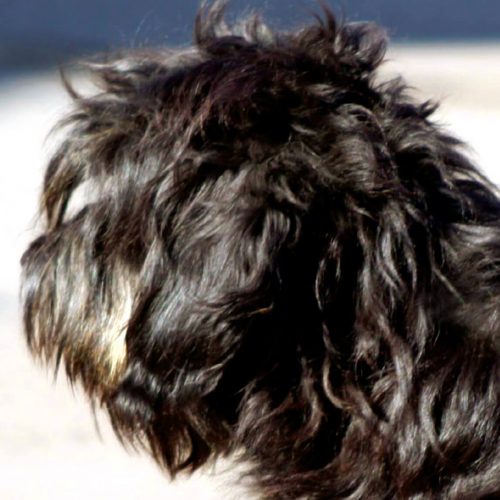Portuguese Sheepdog
Portuguese breed recognized by the FCI
(Standard FCI Nº 93)
Origin | Portugal |
Date of publication of the original valid standard | 04-11-2008 |
Utilization | Sheepdog for herding and watching over livestock. |
F.C.I. Classification | Group 1 – Sheepdogs and Cattle Dogs (except Swiss Cattle Dogs).
Section 1 – Sheepdogs. Without working trial. |
Height and Weight | Males: 45-55 cm.
Females: 42-52 cm. Weight: Males and females: 17-27 Kg. |

Brief Historical Summary
Sheepdog used in the Alentejo region for herding and watching different kinds of livestock; sheep, cattle, horses, goats and pigs. An austere and rustic dog perfectly adapted to the area’s temperature changes and with great endurance for covering long distances herding livestock through the Alentejo plains.
Behaviour/Temperament
It is always vigilant and successfully alerts for the proximity of predators. The breed is extremely devoted to its work and its shepherd. The work is conducted with joy and pleasure.
General Appearance
Medium sized dog, medium long (sub-longilinear), with appreciable rusticity and sobriety, extremely agile and swift, with ample and suspended movement. Long hair of goat-like texture, without undercoat. It has simian-like attitudes and appearance, which is why
it is known in its native region as “monkey dog”.
Important Proportions
The length of the body is approximately 10% more than the height at the withers.
The depth of chest is less than 50% of height at the withers. The muzzle length is 2/3 of the skull length; the width of the skull is slightly less than its length.Head
Medium sized (mesocephalic), strong, broad, neither long nor massive.
Cranial Region
Skull: Tending to square, slightly longer than broad; divergent longitudinal axes of the skull and muzzle; convex on both axes, but more laterally. The superciliary arches are not prominent. The frontal furrow is pronounced and extends to the middle of the forehead; the area between ears is almost flat with apparent occipital protuberance.
Stop: Well defined.
Facial Region
Nose: Well defined, slightly raised and with ample nostrils, rounded, cylindrical and truncated almost vertically; preferably black, may be liver coloured in yellow and brown animals, but should always be darker than the coat.
Muzzle: Short, measuring two thirds of the skull length; almost cylindrical; the width being proportional to its length and shape. Straight in profile or slightly concave.
Lips: Close fitting, not overlaid, almost straight, thin, firm. Edges of the same colour as the nose.
Jaws/Teeth: Normally developed, with perfect opposition of both jaws; full dentition, with 42 solid white teeth; scissors bite, pincer bite accepted.
Eyes: Medium sized; rounded; preferably dark in colour, but may be hazelnut or amber in brown and yellow animals; set level not prominent. Lively expression, intelligent but docile; horizontal lids black or always darker than the coat, in accordance with the colour of the nose.
Ears: High-set; hanging and not folded; triangular. Thin and smooth skin. Medium sized, of the same length and width (approximately 10 cm).
Neck
Harmoniously attached to head and body; of moderate length; straight and slightly rising, moderately thick with strong muscles; without dewlap
Body
Top line: Level or slightly sloping.
Withers: Strong and harmoniously attached to the neck and back.
Back: Straight or slightly sloping and long; well muscled; almost twice as long as the loin.
Loin: Short and arched seen in profile; broad and curved seen from the front; strongly muscled and well attached to the back and croup.
Croup: Slightly prominent and sloping; smoothly; of medium length and width; strong muscles.
Chest: Down to the elbows; of medium width and depth; slightly arched ribs, with oval rib cage, slanting to the back; the forechest is prominent, broad, well let back and ample.
Underline and belly: Uprising with moderately tucked up belly and slightly rising flanks.
Tail
Set on high; pointed; reaching the hocks; tapering from the base. Long and abundant hair. When at rest falls between the buttocks slightly arched and curved at the tip, in action it either extends the backline or may curve slightly over the top line, but never curled over the back.
Forequarters
Strong, upright when seen from the front and side and well set apart; the distance from withers to elbow is slightly less than from elbow to ground.
Shoulder: Of medium length; with a 45º lay back; well muscled; scapula-humerus placed at a 90º angle.Upper arm: Strong and of medium length; set at a 45º angle; well muscled.
Elbow: Parallel, close to the chest and with a 135º humerus-radius angle.
Forearm: Long; vertical and well muscled with bone of medium thickness.
Carpus (Pastern joint): Lean and not prominent.
Metacarpus (Pastern): Of medium length; and medium thickness; neither sloping nor perfectly upright.
Forefeet: Rounded (not splayed); long and with tight and pronouncedly arched toes; strong nails, black or darker than coat colour. Thick and hard pads.
Hindquarters
Medium width, uprightwhen seen from the rear; strong; giving a perfect impression of power and agility.
Thigh: Of medium length and width; well muscled; hip-femur angle approximately 105º.Stifle joint: Straight seen from the rear not inclined inwards or outwards. Strong femur-tibia angle approximately 130º.
Second thigh: Long; slightly inclined; well muscled; strong bones.
Hock: Of medium width; low set strong and lean; tibia-tarsus angle approximately 120º.
Metatarsus (rear pastern): Of medium length and thickness, but strong; neither sloping nor perfectly upright. May have single or double dewclaws.
Hind feet: Identical to the forefeet in all aspects.
Gait/Movement
Predominantly it moves in a light and suspended trot, with great reach. The gallop, when the work requires it, is energetic.
Skin
Thick; flexible; not very tight; internal and external mucous membranes preferably pigmented.
Coat
HAIR: Straight or slightly wavy; long; with slightly harsh texture preferably goat-like; forming long beard, moustache and eyebrows, but not covering the eyes; dense and evenly distributed over the body, including between toes; hair of medium thickness; without undercoat or woolliness; very long coat on head, body and limbs, including between toes.
COLOUR: Yellow, brown, grey, fawn and wolf-grey, in light, medium and dark shades and black; with tan markings more or less noticeable, but should never be pied, except for a very small white spot on the chest.Faults
Any departure from the foregoing points should be considered a fault and the seriousness with which the fault should be regarded should be in exact proportion to its degree and its effect upon the health and welfare of the dog.
Severe Faults
Behaviour: Animals showing nervous, unbalanced temperament.
Jaws: Incorrect implantation of teeth, lack of two premolars (except PM1).
Stop: Not pronounced.
Nose: Pointed.
Lips: Overlapping or pendulous.
Eyes: Light, small, slanting or not rounded.
Ears: Folded or rose-shaped.
Forechest: Too narrow.
Chest: Shallow, flat rib cage.
Top line: Saddle back or too sloping.
Croup: Horizontal or too sloping.
Underline: Too much tick-up.
Limbs: Tilted fore-or hind feet, cow hocks, and hindquarters must not be straight.
Tail: Low set, short or curled over back, when at rest.
Nails: White.
Hair: Not harsh enough or not long enough.
Colour: White spot on the chest too large; tan points not defined.
Gait: Not ample enough, not suspended, out at the elbows, hocks too close.
Eliminating Faults
Behaviour: Aggressive or overly shy.
General appearance: Lymphatic, light boned. Serious deviations from the important proportions.
Head: Narrow and long.
Skull: Narrow, flat or globular.
Ears: Low set, or too wide apart, erect or semi-erect.
Muzzle: Convex profile.
Jaws: Undershot or overshot lack of more than two pre-molars (except PM1).
Pigmentation: Total lack of pigmentation on nose, eyelids and lips (albinism).
Tail: Docked or absent at birth.
Hair: Short, curly, or with undercoat.
Colour: White on the extremities of limbs or pied. Lack of tan points in brown, grey and black adults.
Gait: Too hobbled and heavy, or with serious deviations of forelegs, frailness.
Size: Oversized or Undersized.
Notes:
Any dog clearly showing physical or behavioural abnormalities shall be disqualified.
N.B.: Male animals should have two apparently normal testicles fully descended into the scrotum.














